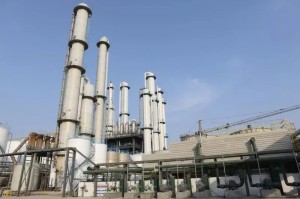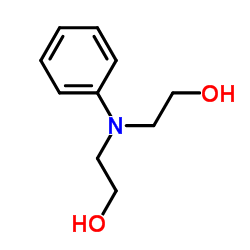-

CAS NO.3077-12-1 N,N-Bis(2-hydroxyethyl)-p-toluidine/High quality/Best price/In stock
Product name: N,N-Bis(2-hydroxyethyl)-p-toluidine
CAS: 3077-12-1
Molecular formula:C11H17NO2
Molecular weight: 195.261
EINECS No.:221-359-1
Purity:≥99%
Density: 1.137 g/cm3
PSA: 43.70000
LogP: 0.78600
Melting Point: 49-53 °C(lit.)
Boiling Point: 339 °C at 760 mmHg
Flash Point: 208.9 °C
Safety:26-36-61-39
Risk Code: 36/37/38-52/53-41-37/38-22
Brand:MIT -IVY INDUSTRY CO.,LTD
Other names:Ethanol,2,2'-(p-tolylimino)di- (6CI,7CI,8CI);2,2'-(p-Tolylimino)diethanol;Diethylol-p-toluidine;N,N-Bis(2-hydroxyethyl)-4-methylaniline;N,N-Bis(2-hydroxyethyl)-4-toluidine;N,N-Bis(2-hydroxyethyl)-p-toludine;N,N-Bis(2-hydroxyethyl)-p-toluidine;N,N-Bis(b-hydroxyethyl)-p-toluidine;N,N-Di(b-hydroxyethyl)-p-toluidine;N,N-Diethanol-p-methylphenylamine;N,N-Diethanol-p-toluidine;N-(4-Methylphenyl)diethanolamine;N-(p-Methylphenyl)-N,N-diethanolamine;N-(p-Methylphenyl)diethanolamine;N-p-Tolyldiethanolamine;NSC 103354;PT 2HE;Plexilith 492;
Port: any port in china
Packing:according to the clients requirement
Storage: Store in dry, dark and ventilated place.
Transportation: by sea or by air
payment methods: L/C, T/T, D/A, D/P, O/A, paypal, western union etc.accept all payment. -

CAS NO.696-44-6 N-Methyl-m-toluidine/High quality/Best price/In stock
Product name:N-Methyl-m-toluidine
CAS:696-44-6
Molecular formula C8H11N
Molecular weight: 121.182
EINECS No.: 211-795-0
Purity:≥99%
Density: 0.968 g/cm3
PSA:12.03000
LogP: 2.10970
Melting Point: -10.08°C (estimate)
Boiling Point: 204.7 °C at 760 mmHg
Flash Point:77.3 °C
Safety: 28-36/37-45-61-28A
Risk Code: 23/24/25-33-52/53
Brand:MIT -IVY INDUSTRY CO.,LTD
Other names:m-Toluidine,N-methyl- (6CI,7CI,8CI);N,3-Dimethylaniline;N,3-Dimethylbenzenamine;N-(3-Methylphenyl)methylamine;N-Methyl(3-methylphenyl)amine;N-Methyl-N-(3-methylphenyl)amine;N-Methyl-N-(m-tolyl)amine;N-Methyl-m-toluidine;NSC 9396;m,N-Dimethylaniline;
Port: any port in china
Packing:according to the clients requirement
Storage: Store in dry, dark and ventilated place.
Transportation: by sea or by air
payment methods: L/C, T/T, D/A, D/P, O/A, paypal, western union etc.accept all payment. -

CAS NO. 120-07-0 N-Phenyldiethanolamine N,N-DIHYDROXY ETHYL ANILINE (NNDHEA) Manufacturer/High quality/Best price/In stock /sample is free/DA 90DAYS
Product Name:N,N-Dihydroxyethylaniline
CAS: 120-07-0
Molecular formula:C10H15NO2
Molecular weight: 181.23
EINECS No.: 204-368-5
Density: 1.165
Melting point: 55-59°C
Boiling point: 270°C
Refractive index: 1.5464 (estimate)
Flash point: 200°C
Other names:2,2'-(Phenylimino)diethanol;N,N-Dihydroxy ethyl aniline (NNDHEA);N-Phenyldiethanolamine;2-[N-(2-hydroxyethyl)anilino]ethanol;N,N-Dihydroxy ethyl aniline (NNDHEA);N-Phenyldiethanolamine;2,2μ-(Phenylimino)diethanol,N,N-Bis(2-hydroxyethyl)aniline,N-Phenyl-2,2μ-iminodiethanol;2,2'-(phenylaChemicalbookzanediyl)diethanol;3-Phenyl-3-azapentane-1,5-diol;Anilinodiethanol;N,N-Bis(2-hydroxyethyl)benzenamine
Purity:≥99%
Brand:MIT -IVY INDUSTRY CO.,LTD
Appearance: colorless to slightly yellow crystals
Uses:Used as intermediates of medicine and dyes
Port: any port in china
Packing: according to the clients requirement
Storage: Store in dry, dark and ventilated place.
Transportation: by sea or by air
payment methods: L/C, T/T, D/A, D/P, O/A, paypal, western union etc.accept all payment. -

2-(N-Ethyl-m-toluidino)ethanol CAS: 91-88-3 High Purity 99% /sample is free/DA 90 days-
Product Name: 2-(N-Ethyl-m-toluidino)ethanol
CAS: 91-88-3
Molecular formula: C11H17NO
Molecular weight: 179.26
EINECS No.: 202-105-9
Purity:≥99%
Brand:MIT -IVY INDUSTRY CO.,LTD
Other names:2-(N-ETHYL-M-TOLUIDINO)ETHANOL;3-METHYL-N-ETHYL-N-BETA-HYDROXYETHYLANILINE;3-METHYL-N-ETHYL-N'-HYDROXYETHYLANILINE;N-ETHYL-N-HYDROXYETHYL-META-TOLUIChemicalbookDINE;N-ETHYL-N-HYDROXYETHYL-M-TOLUIDINE;N-ETHYL-N-(2'-HYDROXYETHYL)-3-TOLUIDINE;N-ETHYL-N-(2-HYDROXYETHYL)-M-TOLUIDINE;2-(ethyl(m-tolyl)amino)ethanol
Appearance: Powder to block to transparent liquid, white or colorless to yellow to orange.
Application:Used as dye intermediates, such as Disperse Blue 102, 106, Disperse 32, 98, 109, etc. Color film developer raw material.
Port: any port in china
Packing: 200kg/drum OR according to the clients requirement
Storage: Store in dry, dark and ventilated place.
Transportation: by sea or by air
payment methods: L/C, T/T, D/A, D/P, O/A, paypal, western union etc.accept all payment. -

N-Methylaniline CAS 100-61-8 NMA Octane Booster Purity≥ 99% Monomethyl Aniline
N-Methylaniline
CAS: 100-61-8
PURITY ≥99%
Molecular formula C7H9N
NO 101.15
EINECS number 202-870-9
Port: any port in china
Packing:according to the clients requirement
Storage: Store in dry, dark and ventilated place.
Transportation: by sea or by air
payment methods: L/C, T/T, D/A, D/P, O/A, paypal, western union etc.accept all payment. -
![[Copy] Sodium chloride CAS 7647-14-5](https://cdn.globalso.com/mit-ivy/微信图片_20240704163118.jpg)
[Copy] Sodium chloride CAS 7647-14-5
Sodium chloride is the main component of table salt and rock salt. It is an ionic compound and is a colorless and transparent cubic crystal. Sodium oxide exists in large quantities in seawater and natural salt lakes. It can be used to produce chlorine, hydrogen, hydrochloric acid, sodium hydroxide, chlorate, hypochlorite, bleaching powder and metallic sodium. It is an important chemical raw material; Chemicalbook can be used in food Seasoning and marinating fish, meat and vegetables, as well as for salting out soap and tanning leather, etc.; highly refined sodium chloride can be used to make physiological saline for clinical treatment and physiological experiments, such as sodium loss, water loss, blood loss, etc. Sodium chloride can be produced by concentrating crystalline seawater or natural salt lake or salt well water.
Sodium chloride is an important chemical raw material for the preparation of chlorine gas, metallic sodium, caustic soda, soda ash and other substances, and is widely used in dyes, ceramics, metallurgy, leather, soap, refrigeration, etc. In analytical chemistry, sodium chloride is a reagent for the determination of fluorine and silicate, and a benchmark reagent for calibrating silver nitrate.
Sodium chloride is an important matrix for maintaining extracellular fluid volume. It also has a certain regulatory effect on the acid-base balance of body fluids. It is also one of the important factors in maintaining neuromuscular stress. Mainly used to prevent and treat hyponatremic syndrome, sodium deficiency dehydration (such as burns, diarrhea, shock, etc.), heat stroke, etc.; externally used for eyewash, nose, wounds, etc.; intravenous injection of 10% hypertonic sodium chloride solution can promote gastrointestinal Peristalsis, improve digestive function.
-
![[Copy] CAS NO.112-57-2 Tetraethylenepentamine (TEPA) Manufacturer/High quality/Best price/In stock](https://cdn.globalso.com/mit-ivy/112-57-2.png)
[Copy] CAS NO.112-57-2 Tetraethylenepentamine (TEPA) Manufacturer/High quality/Best price/In stock
Product name:Tetraethylenepentamine (TEPA)
CAS:112-57-2
Molecular formula:C8H23N5
Molecular weight:189.3
EINECS No.:203-986-2
Appearance: Yellow or orange-red viscous liquid
Purity:≥99%
Brand:MIT -IVY INDUSTRY CO.,LTD
Port: any port in china
Packing:according to the clients requirement
Storage: Store in dry, dark and ventilated place.
Transportation: by sea or by air
payment methods: L/C, T/T, D/A, D/P, O/A, paypal, western union etc.accept all payment. -

CAS NO.92-50-2 N-Ethyl-N-hydroxyethylaniline/High quality/Best price/In stock
Product name: N-Ethyl-N-hydroxyethylaniline
CAS:92-50-2
Molecular formula: C10H15NO
Molecular weight: 165.235
EINECS No.: 202-160-9
Purity:≥99%
Density: 1.046 g/cm3
PSA: 23.47000
LogP: 1.50520
Melting Point: 36-38 °C(lit.)
Boiling Point: 278.5 °C at 760 mmHg
Flash Point:131 °C
Safety: 36/37/39-26
Risk Code: 22-36/37/38
Brand:MIT -IVY INDUSTRY CO.,LTD
Other names:Ethanol,2-(N-ethylanilino)- (6CI,7CI,8CI);2-(Ethylphenylamino)ethanol;2-(N-Ethylanilino)ethanol;Ethylphenylethanolamine;N-(2-Hydroxyethyl)-N-ethylaniline;N-Ethyl-N-(2-hydroxyethyl)aniline;N-Ethyl-N-phenylaminoethanol;NSC 7485;b-Ethylanilinoethyl alcohol;
Port: any port in china
Packing:according to the clients requirement
Storage: Store in dry, dark and ventilated place.
Transportation: by sea or by air
payment methods: L/C, T/T, D/A, D/P, O/A, paypal, western union etc.accept all payment. -

2-Ethylhexylamine CAS:104-75-6 Purity: >99% Intermediates of pesticides, feedstocks, surfactants, and insecticides
2-Ethylhexylamine
CAS: 104-75-6
PURITY ≥99.%
Molecular formula :C8H19N
NO 129.24
EINECS number 203-233-8
Port: any port in china
Packing:according to the clients requirement
Storage: Store in dry, dark and ventilated place.
Transportation: by sea or by air
payment methods: L/C, T/T, D/A, D/P, O/A, paypal, western union etc.accept all payment. -

CAS NO.148-87-8 3-Ethylanilinopropiononitrile/High quality/Best price/In stock
Product name: 3-Ethylanilinopropiononitrile
CAS:148-87-8
Molecular formula: C11H14N2
Molecular weight:174.246
EINECS No.: 205-728-4
Purity:≥99%
Density: 1.022 g/cm3
PSA: 27.03000
LogP: 2.42658
Melting Point: N/A
Boiling Point: 311.9 °C at 760 mmHg
Safety: 24/25
Risk Code: N/A
Brand:MIT -IVY INDUSTRY CO.,LTD
Other names:Propionitrile,3-(N-ethylanilino)- (6CI,7CI,8CI);3-(Ethylphenylamino)propionitrile;3-(N-Ethylanilino)propionitrile;N-(2-Cyanoethyl)-N-ethylaniline;N-Ethyl-N-(2-cyanoethyl)aniline;N-Ethyl-N-(b-cyanoethyl)aniline;N-b-Cyanoethyl-N-ethylaminobenzene;N-b-Cyanoethyl-N-ethylaniline;NSC81243;
Port: any port in china
Packing:according to the clients requirement
Storage: Store in dry, dark and ventilated place.
Transportation: by sea or by air
payment methods: L/C, T/T, D/A, D/P, O/A, paypal, western union etc.accept all payment. -

N-Ethyl-N-benzylaniline-3′-sulfonic acid CAS 101-11-1 High Purity 99% /sample is free/
Product Name:N-Ethyl-N-benzylaniline-3'-sulfonic acid
CAS: 101-11-1
Molecular formula: C15H17NO3S
Molecular weight: 291.37
EINECS No.: 202-916-8
Purity:≥99%
Brand:MIT -IVY INDUSTRY CO.,LTD
Other names:3-(N-Ethyl-N-phenylaminomethyl)benzenesulfonicacid;3-[(N-Ethylanilino)methyl]benzenesulfonicacid;3-[(N-Ethyl-N-phenylamino)methyl]benzenesulfonicacid;4-Amino-2-nitrodiphe;3-{[ethyl(pChemicalbookhenyl)aMino]Methyl}benzene-1-sulfonicacid;3-[(ethylphenylamino)methyl]-benzenesulfonicaci;3-[(ethylphenylamino)methyl]-Benzenesulfonicacid;alpha-n-ethylanilinotoluene-3-sulphonicacid
Appearance: White to light brown solid
Application:Intermediates for the production of food dye brilliant blue
Port: any port in china
Packing: 200kg/drum OR according to the clients requirement
Storage: Store in dry, dark and ventilated place.
Transportation: by sea or by air
payment methods: L/C, T/T, D/A, D/P, O/A, paypal, western union etc.accept all payment. -

N-(2-HYDROXYETHYL)-N-METHYL-4-TOLUIDINE CAS: 2842-44-6 High Purity 99% /sample is free/
Product Name: N-(2-HYDROXYETHYL)-N-METHYL-4-TOLUIDINE
CAS: 2842-44-6
Molecular formula: C10H15NO
Molecular weight: 165.23
EINECS No.: 220-638-5
Purity:≥99%
Brand:MIT -IVY INDUSTRY CO.,LTD
Other names:N-(2-HYDROXYETHYL)-N-METHYL-4-TOLUIDINE;2-(N-methyl-p-toluidino)ethanol;N-Methyl-N-hydroxyethyl-P-toluidine;N-(2-Hydroxyethyl)-N-methyl-pChemicalbook-toluidine;2-[Methyl(4-methylphenyl)amino]ethanol;2-(N-Methyl-N-4-tolylamino)ethanol;FirstCureMHPT;N-Methyl-N-(2-hydroxyethyl)-p-toluidine
Appearance: Viscous liquid
Application:In chemical catalytic curing industrial production, N-methyl-N-hydroxyethyl-p-toluidine is an important organic compound with catalytic curing properties.
Port: any port in china
Packing: 200kg/drum OR according to the clients requirement
Storage: Store in dry, dark and ventilated place.
Transportation: by sea or by air
payment methods: L/C, T/T, D/A, D/P, O/A, paypal, western union etc.accept all payment.





